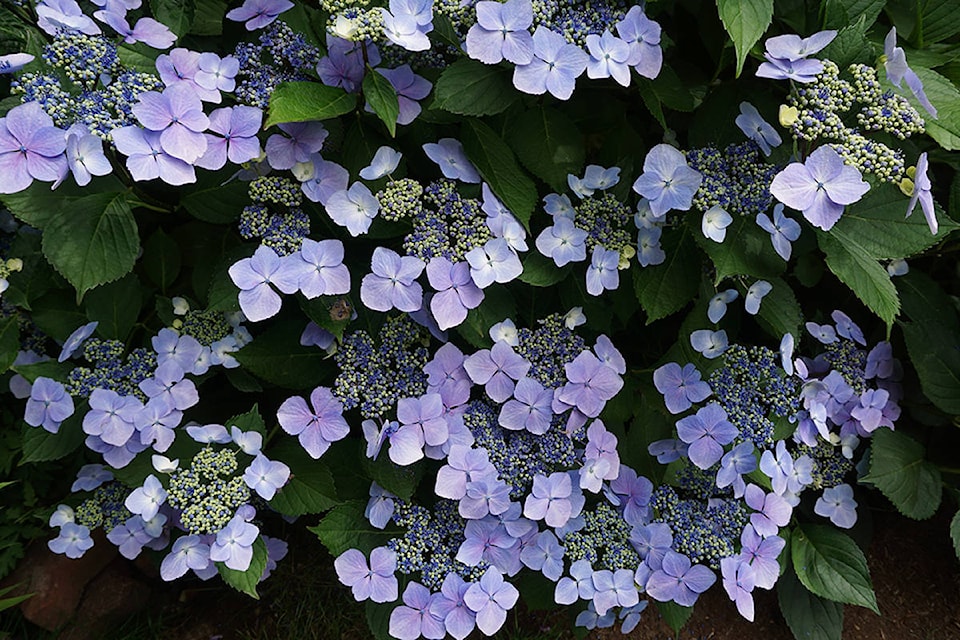It is hard to argue the charm of big leaf hydrangeas in the garden as it progresses from midsummer into autumn.
Known botanically as Hydrangea macrophylla, this species is made up of two types: Hortensia (mophead) and Lacecap.
Mopheads, with their large, globe-like flowers made up exclusively of male flowers, have long been a staple shrub in many gardens. Lacecaps, resplendent in their adornment of flat-capped disks of short female flowers ringed with larger, male flowers, are fast gaining in popularity.
Between the two types, the macrophylla group is the largest of the hydrangea species. And easy care if you keep a few key points in mind. Siting in the garden is paramount. Both mopheads and lacecaps prefer morning sun and afternoon shade. Too much hot sun and you risk scorching leaves and flower petals.
Preference is for humus-rich soil, although they will perform decently in lesser conditions. Regular water is a must but hydrangeas resent being water-logged so good drainage is paramount.
Soil acidity is not too critical with hydrangeas. They tolerate both acid and alkaline conditions. In fact, when in flower, the macrophyllas are a good indication of what the pH value is in your garden. Blue flowers indicate acid soil; pink means alkaline.
Some gardeners have asked how to change the flower colour. Truthfully, it is better to work with the soil pH you have in your garden rather than mess with adding chemicals. This upsets the balance in your soil and can affect both soil microbes and other plants in the vicinity.
But if you absolutely must have pink flowers instead of blue, it is best to transfer your hydrangea into a large planter where soil alteration will not impact neighbouring plants. However, the “fix” is the same even if you have to leave your shrub in the ground.
To change blue into pink, annual amendments of limestone or chalk (calcium carbonate) are needed.
To change pink into blue is more difficult…assuredly impossible if your soil is high alkaline. If at the lower alkaline end, you should achieve success with annual amendments of aluminum sulfate. Best success is achieved when treating hydrangeas in planters. (Check your garden centre for “hydrangea bluing compound”.)
Pruning both mopheads and lacecaps is easy. They produce blooms on last year’s growth, or old wood. I typically wait for my big leaf hydrangeas to start forming leaf buds in spring before I start hacking.
First order is to cut branch tips back to two healthy, opposing leaf buds. If there is only a single bud, cut back to the healthiest one.
Next I evaluate the health of each branch, looking for the oldest ones, and any which may have winter damage. Making sure to only remove a third of the overall number of branches in the shrub, I cut out the broken ones, then as many of the older ones to complete the tally. However, if there are only a couple of scruffy old branches still left…go ahead and remove them.
A few other hydrangea species worth mentioning:
• Hydrangea anomala subsp. petiolaris - (climbing) - is slow growing and does not mind a north-facing location. Prune right after flowering.
• Hydrangea arborescens - (smooth) - flowers on new wood so can be pruned back hard. Soil acidity does not affect flower colour. ‘Annabelle’ is a good cultivar.
• Hydrangea paniculata – (peegee) – is the hardiest…most are labeled Zone 3. Flowers are cone-shaped and plants can tolerate full sun. ‘Limelight’ and ‘Pinky Winky’ are two cultivars.
• Hydrangea quercifolia – (oakleaf) – is noted for leaves shaped like those on an oak tree and for amazing fall colour.
Leslie Cox co-owns Growing Concern Cottage Garden in Black Creek. Her website is at www.duchessofdirt.ca and her column appears every second Thursday in the Record.
